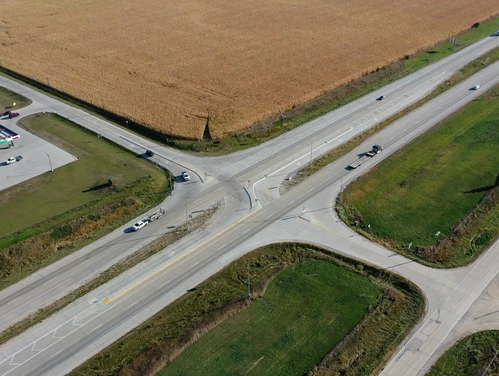What is ICE?
Intersection Control Evaluation (ICE) is a method that uses data and performance measures to help choose the best design and traffic control option for an intersection. ICE leads to safer, more balanced, and cost-effective intersection solutions. It promotes innovative ideas, ensures consistent evaluations, and works for projects of any size.
When is ICE Required?
ICE applies to any state highway project that creates a new intersection or significantly changes an existing one. The Iowa DOT District decides if ICE is needed for a project. For projects where ICE may not be necessary, an ICE Exemption Form (provided in the Iowa DOT ICE Forms Spreadsheet Tool ) should be completed and submitted to the appropriate District Engineer or District ICE representative.
Iowa DOT ICE Materials
Supplemental Tools and Resources
The following are additional supplemental tools and resources for completing ICE.
Iowa DOT Data
- Iowa DOT Traffic Counts
Traffic count data for the state of Iowa that has been collected, processed and published by Iowa DOT. - Iowa DOT Potential for Crash Reduction (PCR)
Online dashboard that provides relative safety of Iowa intersections and roadway segments. - Iowa Crash Analysis Tool (ICAT)
Interactive online tool that analyzes and displays crash data for the state of Iowa. - Iowa-Specific Planning-Level Crash Reduction Factor (CRF) List
Expected reduction in crashes for specific treatments on Iowa facilities.
National ICE Tools
- National Cooperative Highway Research Program (NCHRP) 17-98: Guide for Intersection Control Evaluation
NCHRP Research Report 1087: Guide for Intersection Control Evaluation and supplemental NCHRP Web-Only Document 377: Background and Development of a Guide for Intersection Control Evaluation present guidance and Excel-based spreadsheet tools to help practitioners organize and document an ICE evaluation and perform specific analyses. - National ICE Tools Download
Iowa DOT Reports and Documents
- Iowa DOT Complete Streets Policy
Statewide Complete Streets policy that focuses on improving the safety, access and mobility for all transportation users in Iowa. - Iowa’s Strategic Highway Safety Plan (SHSP)
Statewide coordinated safety plan that provides a comprehensive framework for reducing fatalities and serious injuries on all public roads in Iowa. - Iowa’s Transportation Systems Management and Operations (TSMO) Program
Statewide program that provides strategic direction, program development, and specific steps for systems management and operations in Iowa. - Iowa DOT Traffic and Safety Manual
Manual published by Iowa DOT to provide guidance on how certain activity related to traffic engineering and safety issues are handled. - Iowa DOT Safety Analysis Guide
A methodology for safety processes and procedures on Iowa’s roadways. - Iowa DOT Design Manual
Provides design guidance to designers to assist with projects involving the Primary highway and Interstate systems; Includes design guidance for some alternative intersections considered during ICE.
